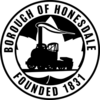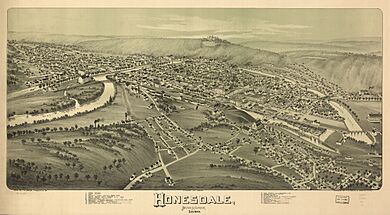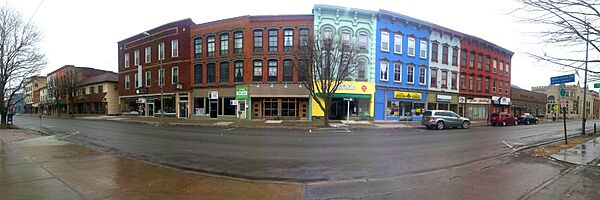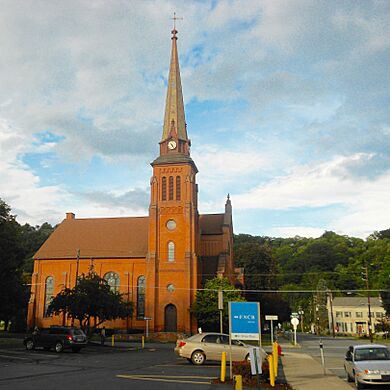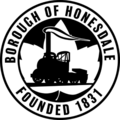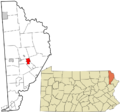Honesdale, Pennsylvania facts for kids
Quick facts for kids
Honesdale, Pennsylvania
|
|||
|---|---|---|---|
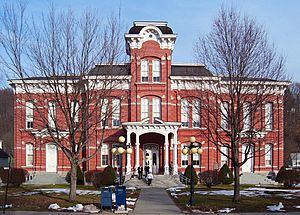
The Wayne County Courthouse in Honesdale
|
|||
|
|||
| Nickname(s):
Dyberry Forks
|
|||
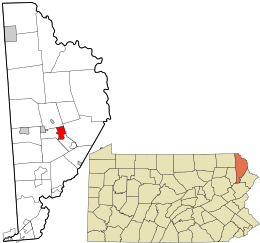
Location in Wayne County and the U.S. state of Pennsylvania.
|
|||
| Country | United States | ||
| State | Pennsylvania | ||
| US Congressional District | PA-8 | ||
| State Senatorial District | 20 | ||
| State House of Representatives District | 111 | ||
| County | Wayne | ||
| School District | Wayne Highlands Region II |
||
| Settled | 1826 | ||
| Incorporated | January 28, 1831 | ||
| Named for | Philip Hone | ||
| Government | |||
| • Type | Mayor-council | ||
| Area | |||
| • Total | 4.02 sq mi (10.42 km2) | ||
| • Land | 3.88 sq mi (10.05 km2) | ||
| • Water | 0.14 sq mi (0.36 km2) | ||
| Elevation | 981 ft (299 m) | ||
| Population
(2020)
|
|||
| • Total | 4,458 | ||
| • Density | 1,148.38/sq mi (443.41/km2) | ||
| Time zone | UTC-5 (Eastern (EST)) | ||
| • Summer (DST) | UTC-4 (Eastern Daylight (EDT)) | ||
| ZIP code |
18431
|
||
| Area code(s) | 570 and 272 | ||
| GNIS feature IDs | 1192628 (Place) 1192628 (Borough) |
||
| FIPS code | 42-35520 | ||
| Major Roads | |||
| Waterways | Bunnells Pond, Carley Brook, Dyberry Creek, Lackawaxen River | ||
Honesdale is a small town, also called a borough, in Wayne County, Pennsylvania, United States. It is the main town, or county seat, of Wayne County. In 2020, about 4,458 people lived there.
Honesdale is located about 32 miles (51 km) northeast of Scranton. It is in a rural area with lots of fun things to do outdoors. You can go boating, fishing, hiking, hunting, skiing, biking, skateboarding, and rafting. Long ago, Honesdale was important for moving coal. It was the start of the Delaware and Hudson Canal, which carried coal to Kingston, New York. From there, coal went down the Hudson River to New York City. Later, railroads became more popular than the canal.
Contents
History of Honesdale
In the early 1800s, a type of coal called anthracite was found in northeastern Pennsylvania. People needed a way to get this coal to New York City. This led to the creation of the Delaware and Hudson Canal, the American Railroad, and the town of Honesdale.
Honesdale was named after Philip Hone. He was a former mayor of New York and the president of the Delaware & Hudson (D&H) Canal Company. The town was first called "Dyberry Forks." It was planned as a village in 1826 when the D&H Canal was built. Honesdale officially became a borough on January 28, 1831.
The Honesdale Residential Historic District and parts of the D&H Canal are special places. They are listed on the National Register of Historic Places because of their historical importance.
Birthplace of American Railroading
Honesdale is famous for being the place where the first commercial steam locomotive ran on tracks in the United States. This locomotive was called the Stourbridge Lion. On August 8, 1829, the Stourbridge Lion traveled three miles from Honesdale to Seelyville and back. Because of this, Honesdale is known as the birthplace of the American Railroad.
The Stourbridge Lion was owned by the Delaware & Hudson (D&H) Canal Company. However, it was too heavy for the tracks and was not used much after its first trip. The D&H company used a special gravity-railroad to move anthracite coal from mines near Carbondale to Honesdale. From Honesdale, the coal was put onto barges and sent through a 108-mile canal to Kingston, New York. Then, it traveled by river barges down the Hudson River to New York City.
Over the years, parts of the Stourbridge Lion were moved around. In 1890, the Smithsonian Institution got what was left of it. Today, the main boiler is on loan at the Baltimore and Ohio Railroad Museum in Baltimore, Maryland.
The Wayne County Historical Society Museum in Honesdale has a full-size copy of the Stourbridge Lion. The museum also shows many old photos, items, and other exhibits. The D&H Railroad Company built this copy using the original plans for an exhibition in Chicago in 1933. The copy was moved to Honesdale in 1941.
You can still ride a train from Honesdale to Hawley on the historic Stourbridge Line. These passenger trips run during certain seasons. The railroad tracks go for twenty-five miles along the Lackawaxen River. The train rides start from the platform at the Wayne County Visitors Center.
Geography and Nature
Honesdale is located at 41°34′27″N 75°15′21″W / 41.57417°N 75.25583°W.
The borough covers a total area of about 4.0 square miles (10.4 km2). Most of this area, about 3.9 square miles (10.1 km2), is land. The rest, about 0.1 square miles (0.3 km2), is water. The Lackawaxen River flows through the middle of the town. The Dyberry Creek also joins the river here. These waters are home to fish and other water animals. They also attract many ducks, eagles, and other birds.
Population and People
| Historical population | |||
|---|---|---|---|
| Census | Pop. | %± | |
| 1830 | 433 | — | |
| 1840 | 1,086 | 150.8% | |
| 1850 | 2,263 | 108.4% | |
| 1860 | 2,544 | 12.4% | |
| 1870 | 2,654 | 4.3% | |
| 1880 | 2,620 | −1.3% | |
| 1890 | 2,816 | 7.5% | |
| 1900 | 2,864 | 1.7% | |
| 1910 | 2,945 | 2.8% | |
| 1920 | 2,756 | −6.4% | |
| 1930 | 5,490 | 99.2% | |
| 1940 | 5,687 | 3.6% | |
| 1950 | 5,662 | −0.4% | |
| 1960 | 5,569 | −1.6% | |
| 1970 | 5,224 | −6.2% | |
| 1980 | 5,128 | −1.8% | |
| 1990 | 4,972 | −3.0% | |
| 2000 | 4,874 | −2.0% | |
| 2010 | 4,480 | −8.1% | |
| 2020 | 4,458 | −0.5% | |
| Sources: | |||
In 2010, there were 4,480 people living in Honesdale. There were 2,086 households, and 1,147 families. The population density was about 1,148.7 people per square mile (443.4 per km2).
Most people in Honesdale are White (96.8%). Other groups include African American (0.9%), Native American (0.1%), and Asian (0.4%). About 2.8% of the population was Hispanic or Latino.
About 26.2% of households had children under 18 living with them. The average household had 2.15 people. The average family had 2.88 people.
About 22.4% of the population was under 18 years old. About 18.8% were 65 years or older. The average age in Honesdale was 42 years.
Media and Publications
Honesdale has local news and media.
- The Tri-County Independent is a local newspaper. It used to be called The Wayne Independent. It focuses on stories from the local area.
- The local radio stations are WDNH 95.3 FM and WPSN 104.3FM, 101.9FM, and 1590 AM. WPSN broadcasts local news, events, weather, and high school football games.
- The children's magazine Highlights for Children was started in Honesdale in 1946. This monthly magazine is for kids aged 6 to 12. It has stories, articles, brainteasers, and famous Hidden Pictures puzzles. The magazine's main office is in Honesdale.
- Yoga International is an online publication based in Honesdale. It shares content about yoga, meditation, and mindful living.
Education in Honesdale
The schools in Honesdale are part of the Wayne Highlands School District.
- Honesdale High School is a public high school for grades 9-12.
- The district also has four elementary schools and one middle school. Stourbridge Primary Center and Lakeside Elementary School serve younger children from Honesdale. Wayne Highlands Middle School serves grades 6-8 in Honesdale.
- The school district is known for its good teaching and high standards for students.
Healthcare Services
Wayne Memorial Hospital serves Honesdale and nearby communities. It is a non-profit hospital. It offers care for many medical needs, with over 30 different specialties.
Wayne Memorial Hospital is the main part of the Wayne Memorial Health System. This system helps about 100,000 people in Wayne and Pike Counties. The Wayne Memorial Community Health Centers offer primary care, dental services, women’s health, and mental health services. In 2019, the hospital finished a big expansion. It added 50 private patient rooms and new technology to improve care.
Places to Visit and See
- Victorian Buildings: Honesdale has many beautiful buildings from the Victorian era. These include tall church steeples and historic structures. Most houses and buildings still look as they did when they were built over a hundred years ago.
- Churches: While a Catholic elementary school closed, two Catholic churches are still active. There are also churches of other Christian groups and a synagogue.
- Irving Cliff: This cliff is 300 feet (91 meters) high and overlooks the town. It was named after writer Washington Irving. From the cliff, you can see where the Lackawaxen River and Dyberry Creek meet. On top of the cliff is Gibbons Memorial Park. It has a large electric framework for a Christmas Star and an Easter Cross. These lights can be seen for miles during holidays. Fireworks are also launched from the cliff for Independence Day celebrations.
- Summer Camps: Many summer camps are located in and around Honesdale. These include Bryn Mawr Camp, Camp Cayuga, Camp IHC, Camp Lavi, Camp Morasha, Camp Moshava, Camp Nesher, Camp Ramah in the Poconos, Camp Raninu, Camp Seneca Lake, Summit Camp, Camp Towanda, Trail's End Camp, Tyler Hill Camp, Camp Watonka, Camp Wayne, and Camp Weequahic. Many campers come from the New York Metropolitan Area, New England, and Philadelphia. These camps are a very important part of the county's economy.
- Cranker's Collection of Mechanical Marvels: This is a private collection of old cars, mostly from the 1920s and 1930s. It also has old dance hall organs, Edison phonographs, and other music boxes from the 1800s.
Arts and Culture
- Wayne County Arts Alliance: This group helps promote art in the county. One of their projects is The Great Wall of Honesdale. It is a large public art display at 4th Street and Main Street. There are also several other murals along Main Street.
- Wayne County Fair: Honesdale hosts the yearly Wayne County Fair. It starts on the first Friday in August and lasts for nine days. The fair has food stands, horse racing, animal contests, amusement rides, and concerts. Nearly 100,000 people visit the fair each year.
- Honesdale Roots and Rhythm Music and Arts Festival: This festival happens in Honesdale on the third Saturday in June. The main stage is in Central Park, with artists and food vendors nearby. Other stages around town offer music all day.
- The Cooperage Project: This center is in an old barrel-making factory. It hosts many events, including music and theater shows. It also offers educational programs for all ages. The Main Street Farmers' Market, where farmers sell directly to the community, is also run from this building.
- Himalayan Institute: The Himalayan Institute of Yoga Science and Philosophy is a non-profit group. It offers programs on yoga, meditation, and spiritual topics. It was founded in 1971 by Swami Rama. Its main headquarters are in Honesdale. The institute also works on humanitarian projects in other countries.
Notable People from Honesdale
Many interesting people have connections to Honesdale:
- Brian Balthazar (born Brian Balthaser), a television personality.
- John J. Boyle, who was the 19th Public Printer of the United States.
- Emma May Buckingham, a writer, educator, and author.
- Florence Goodenough, a pioneer in psychology who studied intelligence.
- Mary Dimmick Harrison, the second wife of President Benjamin Harrison.
- Edgar Jadwin, a former Chief of Engineers for the U.S. Army Corps of Engineers.
- Frederick W. Keator, an Episcopal bishop.
- Lyman Lemnitzer, a U.S. Army general and former chairman of the Joint Chiefs of Staff.
- John Olver, a former member of the U.S. House of Representatives.
- David M. Peterson, a flying ace from World War I.
- Richard B. Smith, who helped write the famous song "Winter Wonderland" in 1934. His house is still on Church St. in Honesdale.
- Richard J. Tallman, a U.S. Army Brigadier-General who died in Vietnam.
- Clarissa Tracy, a botanist who taught here.
- Art Wall Jr., a professional golfer and 1959 Masters champion.
- Morris Wilkins, who invented the heart-shaped bathtub.
- Q. David Bowers, an author and expert on coins and currency.
- Ruth McGinnis, a World Women’s Billiard Champion in the 1930s.
Images for kids
-
Location in Wayne County and the U.S. state of Pennsylvania.
See also
 In Spanish: Honesdale para niños
In Spanish: Honesdale para niños



